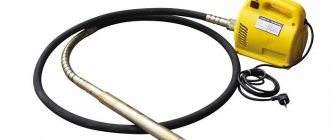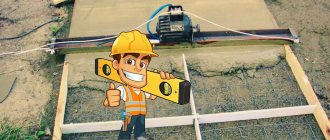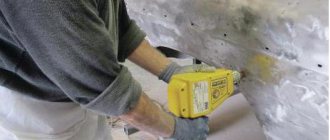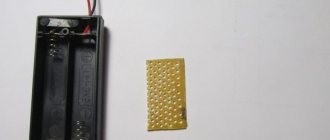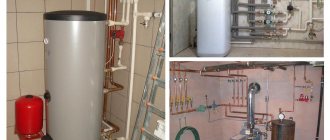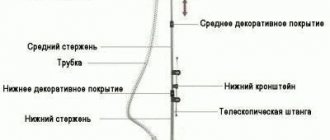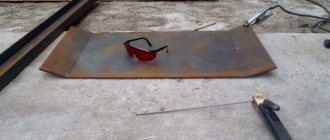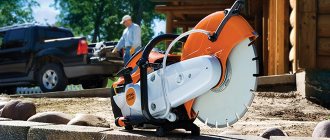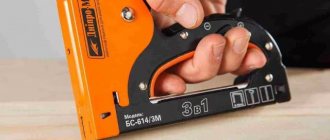Home |Technique and materials |Do-it-yourself deep vibrator for concrete
Date: May 23, 2017
Comments: 0
Concrete is widely used in construction and repair work. The material is indispensable due to its increased strength and reliability, which allows concrete structures to be used for a long time. An internal vibrator for concrete helps to ensure a homogeneous structure of the monolith, compacting the solution and removing air inclusions from the mass.
Today there are many types of vibration compactors available. Their purchase is advisable if concrete is poured in significant volumes. With small foundation dimensions, using available power tools and available materials, you can save financial resources and make a concrete vibrator with your own hands. Such a device will practically not differ in operating efficiency from its factory counterpart.
Let us dwell on the principle of operation, purpose, types and technical characteristics of the device. Let's consider recommendations for self-production.
Since air still gets in when mixing and laying the solution, you have to remove it with something
Why do you need a deep concrete vibrator?
During the mixing process, the concrete solution is actively saturated with air. This reduces the strength characteristics of concrete structures and negatively affects the reliability and service life. You can avoid negative factors if you use a submersible vibrator, the main functions of which are:
- ensuring a uniform consistency of the concrete solution;
- elimination of air cavities in the thickness of the massif;
- removing excess moisture from the concrete composition;
- increasing the strength characteristics of the material.
After vibration compaction, the plasticity and compliance of the concrete composition increases. The intensity of concrete shrinkage also increases and the curing time is reduced.
Criteria for selecting downhole equipment
In order to choose the right deep vibrator, you need to consider how much work you will have to deal with and what needs to be processed: beam, foundation, slab, etc. After indicating the purpose and direction of work, it is already possible to determine the technical characteristics of the deep-well unit, such as drive type, engine power, length of the flexible shaft, diameter of the mace, vibration frequency and others.
First you need to decide on the type of power drive. If you have access to an electrical network, you can choose an electric motor. If not, then a fuel-based, diesel or gasoline engine will do.
The power of the power drive is also an important characteristic when choosing a deep vibrator, which is in the range of 400-1500 W. The quality and duration of work depends on it. There are more powerful engines that are used in the construction of large-scale structures.
The length of the soft shaft can be up to 12 meters, which depends on the operating depth of the deep vibrator.
The choice of vibrating tip diameter depends on the thickness of the concrete layer and is 0.25 of it. Typically, tips are supplied with diameters ranging from 28 to 60 mm.
The delivery package must include a passport for the product, a certificate of conformity, and a warranty card. The price of deep-well equipment directly depends on the manufacturer of the product and the technical characteristics of the product, which ranges from 5000-7000 rubles, depending on whether the vibrator is a manual or an industrial one.
Operating principle
In formwork with reinforcement filled with concrete, it is problematic to mix the solution manually. Using a steel rod to “bayonet” a concrete mass does not bring the desired effect. There is a need to use a device that transmits high-frequency vibrations to the solution.
To remove air and improve the connection between concrete particles - these are the tasks that a construction vibrator performs
Based on the principle of impact on concrete mortar, devices are divided into types:
- Submersible-type vibration compactors (deep), which transmit high-frequency vibrations to the concrete mass through the body of the submersible nozzle.
- External platform-type devices placed on the formwork that transmit vibration to the concrete mass.
- Surface devices, the vibration from which is transmitted to a specific work area where the concrete solution is laid.
A submersible device that creates high-frequency oscillations in the thickness of the massif is widely used.
The operating feature of the vibrating compactor, which implements this principle, is based on the removal of air bubbles from the concrete solution. A high-frequency vibrator transmits vibration energy to the concrete through the working element, mixing it. Lighter air bubbles tend to rise outward. This increases the moisture resistance of the monolith, relieves internal stress, and reduces the likelihood of shell formation.
Is it profitable to rent a vibrator?
If you work in a construction team and are constantly involved with the construction of the foundation, then, of course, spending money on rent is not profitable for you. It’s better to invest once and purchase tools of proper quality. If you are a private person and are pouring a foundation, where work is usually completed within one day, then renting a deep vibrator is simply necessary for you.
There is no point in buying a tool that will then sit on your shelf and remain idle. Renting such an instrument is inexpensive, usually 400-800 rubles. in one day, so you can easily afford it.
At the same time, you will receive a guaranteed working tool, which you will then return and will not clutter up your own shelves in the garage. By the way, this is convenient in the early stages, since when construction begins there is simply no place where you could store it all. They brought it, worked, and returned it.
Deep vibrator device
The submersible vibration compactor of the electromechanical type is designed quite simply. It consists of the following parts:
- an electric motor, which is a source of energy;
Submersible Portable Concrete Vibrator
- a flexible shaft that acts as a transmission mechanism;
- a generator attachment that creates high-frequency vibrations.
The vibrating tip can have the following shape:
- Cylindrical. This attachment is called a vibrating mace and is used when the solution is of normal thickness.
- Conical. The tip is a vibrating bayonet used to compact thick mixtures.
The working part may include:
- group of vibration attachments;
- vibration tips of various diameters;
- one or more vibrating bayonets.
The main elements of the vibrating attachment:
- Cylindrical body made of stainless steel pipe.
- Roller bearings centering the flexible shaft.
- A bushing that converts rotation into vibrations.
Incorrect use of vibration will not only bring no benefit, but can also cause harm: excessive duration of exposure will cause stratification of the solution, which will negatively affect its strength
By shaft speed
The shaft rotation frequency coincides with the vibration frequency of the nozzle - the number of vibrations per minute.
The vibration frequency can be specified in vibrations/min (vpm) or in Hertz (Hz). The values are related by the following ratio: 1 Hz = 1 vpm/60.
Based on this parameter, vibrators can be divided into:
- low frequency. The shaft rotates at speeds up to 3500 rpm. Low frequencies are capable of moving larger aggregate particles. Such vibrators are suitable for heavy, non-plastic concrete with a “skeleton” of crushed stone or gravel of large fractions;
- mid-frequency. The rotation speed falls in the range from 3500 to 9000 rpm. These are universal models - if configured correctly, they are used for compacting solutions with fillers of different sizes, including the “running” grades M200–M300;
- high frequency. Frequency – from 10,000 to 20,000 rpm. Such vibrating tools have a narrow specialization - fine-grained concrete. For heavy concrete, high frequency compaction may not be effective.
Oscillations are characterized by two quantities – frequency and amplitude. The amplitude of vibrations is directly proportional to the weight of the tool. As the frequency increases, the weight, as a rule, decreases - low-frequency models produce greater amplitude.
In theory, a high vibration frequency implies greater efficiency, regardless of the fractional composition of the mixture. In practice, the result also depends on the amplitude of the oscillations. High-frequency vibration of heavy concrete at low amplitude will only intensify delamination.
Vibrators differ in the size of the working parts:
- submersible - the length of the flexible shaft (from 50 cm to 30 m) and the diameter of the mace (25–140 mm);
- vibration slats – slats length – from 150 to 500 cm (for telescopic slats);
- platform - length (450–620 mm) and width (320–480 mm) of the working surface.
Submersible vibrator - varieties
Submersible type vibration compactors differ in their design features. Applicable:
- electromechanical devices operating from a motor with a supply voltage of 220 or 380 V and a frequency of 50 Hz. Torque through a flexible shaft 1.5–6 m long is converted into vibration of the working body;
- high frequency vibration compactors driven by a motor with a frequency of up to 200 Hz. The voltage converter reduces the motor power to 42 V and ensures the safety of concrete work;
- vibrating compactors with hydraulic drive. A design nuance is the adjustment of the oscillation frequency of the hydraulic motor, which develops pressure up to 120 bar;
- pneumatic devices controlled by a pneumatic motor using a release valve. The devices are easy to maintain and are used in the production of reinforced concrete products;
- electromagnetic type vibrators. A constant frequency of oscillation is created by a spring-loaded armature using an electric magnet. The amplitude of oscillations is affected by the weight of the armature and the elasticity of the springs.
Based on size and performance, devices are divided into the following types:
- Small-sized vibration compactors with low productivity. They are used in the construction of private facilities.
- Standard vibration compactors with vibration frequencies up to 20 thousand per minute. Used in industrial construction.
A high-frequency vibrator is widely used, providing effective compaction of the concrete mass due to its increased efficiency.
High frequency deep vibrator
Types of concrete vibrators, their purpose and use
There are different types of concrete vibrators, which are distinguished by the type of installation:
- Internal or submersible construction vibrators are used to create massive structures. In private construction, they are used when pouring foundations and erecting monolithic walls. They are called so because their tip is immersed in the solution.
- Surface models are used when pouring screeds, floor slabs, large areas of concrete - concreting roads or sites.
- External vibrators are fixed externally to the formwork. This is convenient when creating tall and narrow structures with a dense mesh of reinforcement.
Depending on the type of motor used, concrete vibrators can be electric, pneumatic, or can be powered by an internal combustion engine.
Treatment is carried out immediately after pouring the solution
Electric ones, in turn, can operate from a two-phase 42 V network and from a single-phase 220 V. For private construction, single-phase electric ones are more often used. Moreover, the most common ones are deep ones. This is understandable, because pouring the foundation is one of the most important and complex operations. And deep concrete vibrators are designed specifically for these purposes.
High-frequency vibrator – features of choice and characteristics
When choosing a vibrator for concrete compaction, you should consider several factors:
- nature of construction work;
- features of reinforced concrete structures;
- depth of the concrete mass;
- mesh size of the reinforcement mesh.
For example, to compact a slab-type base with a small thickness, it is enough to use a device with an intermediate shaft of up to 3 m. If the depth of the formwork filled with concrete exceeds 2 m, you will need a vibration compactor with a shaft up to 5 meters long. The diameter of the vibrating tip should be 50% smaller than the mesh size of the reinforcement mesh. This will ensure the necessary penetration of the nozzle and reduce the likelihood of contact with the reinforcement.
The characteristics of deep-hole devices powered by an alternating voltage network differ in the following parameters:
- Supply voltage (220 or 380 V).
- Availability of a residual current device.
- Electric motor power (from 1 to 1.5 kW).
- The frequency of vibrations created by the working body (12–20 thousand rpm).
- Performance depending on motor power and oscillation frequency.
- The length of the intermediate shaft, if necessary, is up to 10 m.
The most effective are high frequency
Peculiarities
Safety precautions when working with electric vibrators are similar to safety precautions when operating other power tools.
It is strictly forbidden to work:
- faulty device;
- with damaged electrical cables;
- if the device is not connected reliably to the network;
- when a burning smell of overheated insulation appears, which indicates either overheating of the electric motor or a short circuit;
- leave a device connected to the network unattended;
It is prohibited to carry out maintenance or repair electrical equipment while the power supply is turned on.
You cannot delegate work with a vibrator to persons who have not received the right to operate this type of device.
But there are also safety features when working with deep vibrators:
- It is prohibited to operate the device without individual means of protecting the human body from the influence of vibration;
- It is forbidden to touch the vibrating mace until the engine has completely stopped;
- Do not keep the operating device closer than 30 cm from the vibrating tip;
- the sound pressure level during operation of the device should not exceed 98 dB;
- The operator should not operate the deep vibrator for more than 72 minutes during any one 8-hour work shift.
How to make a vibrator for concrete with your own hands
For self-production, you can use one of the following devices:
- electric drill;
- small hammer drill with power up to 1.5 kW.
Make a submersible vibrator according to the first option by preparing the following equipment and components:
- Electric drill with a power of 0.65–1.0 kW.
- Welding machine with electrodes.
- A hacksaw for metal.
- Stainless steel pipe with a diameter of 40–45 mm.
- Steel rod with a diameter of 12–15 mm.
- Flexible cable in a waterproofed casing of the required length.
- Bearings in the amount of 2 pieces, corresponding to the internal diameter of the pipe and the dimensions of the steel rod.
A construction vibrator can be made on the basis of any power tool with an adjustable speed
Carry out manufacturing following the sequence of operations:
- Cut a piece of pipe 450–550 mm long.
- Weld an eccentric at the end of the steel rod.
- Install bearings onto the rod with weighting material.
- Insert the assembled assembly into the pipe.
- Weld the end of the pipe.
- Seal the tip exit.
- Connect the cable to the attachment and drill.
The principle of operation of the device is to convert the rotational movement of the flexible shaft into vibrations of the nozzle thanks to the installed eccentric. By adjusting the speed of the electric drill, you can change the amplitude of the oscillations.
For manufacturing, you can use a hammer drill. Required:
- steel pike;
- support washer.
The length of the peak is selected depending on the depth of the formwork. A washer is welded at the end of the rod.
The device is operated in rebound mode. A rod with a washer installed in the hammer drill cartridge rests on the bottom of the formwork and transmits vibrations to the concrete mass. Using a hammer drill with an attachment, it is easy to process significant volumes of solution in a limited time.
Attachment for a rotary hammer or drill
There are times when purchasing a ready-made tool is not advisable. For example, due to small volumes or lack of funds. This problem can be solved by making a seal with your own hands. For these purposes, you can use various household power tools, including a drill or hammer drill. To do this, first of all, you need to purchase or make a tip.
- Drill based seal. To produce a working tool, it is necessary to have a flexible shaft with a vibration device. This problem can be solved in two ways: purchase a ready-made shaft in specialized stores or make it yourself. The easiest way is to purchase a tip in a store. When purchasing a finished shaft, you should pay attention to the diameter of the vibrating tip. With a variety of sizes, it is recommended to choose the optimal size – 35 mm. The length of the shaft should be selected taking into account the conditions of the work being performed. To make a shaft at home, you will need individual parts (pipes, cable), materials, welding, and a set of tools. Some parts, such as the eccentric, must be made on a metalworking machine;
- Compactor based on a hammer drill. To make a simple seal, you need to have a square steel plate measuring 8*8*4 mm. A drill shank is welded on one side of the plate. To compact the solution, the plate should be tightly attached to the outer wall of the formwork. Vibration vibrations from the plate will be transmitted to the wall of the formwork, and from it directly to the liquid solution.
Operating rules
To increase the efficiency of a manual vibrator, experts recommend following the rules for working with it. Among the most significant are the following:
- The nozzle must be immersed in the concrete solution slowly, gradually reaching the maximum depth of the container.
- Keep motionless for 25 - 35 seconds until laitance appears on the surface of the mixture.
- The surface pump head is carefully removed from the container.
- In order to avoid concrete delamination, it is not recommended to keep the vibrator in the concrete mixture for a long time. Otherwise, the possibility of a decrease in the strength and quality of concrete cannot be excluded.
Subject to these operating rules, you can not only extend the life of the unit, but also reduce the labor intensity of the work process.
Principle of operation
Among all types of vibration pumps, the most common are electromechanical. Their design is made up of the following components:
- Electrical engine. Can be powered by 1 or 3 phases from the mains.
- Flexible drive hose. Its length can vary from 1 to 7 m. Its function is to transmit movement to the tip from the rotor, and the ends are sealed with rubber nozzles.
- Mace (working tip). Emits energy.
- Vibrating nozzle. It looks like a tube made of stainless steel. Thanks to this, it is resistant to the development of corrosion in contact with the concrete mass. Inside the nozzle there is a bearing and an eccentric. When the center of gravity of the eccentric and the axis do not coincide, vibration motion occurs.
The popularity of concrete vibrators is due to the simplicity of their design and operation.
